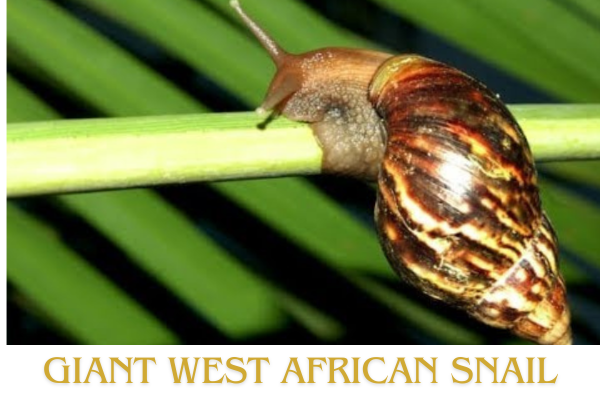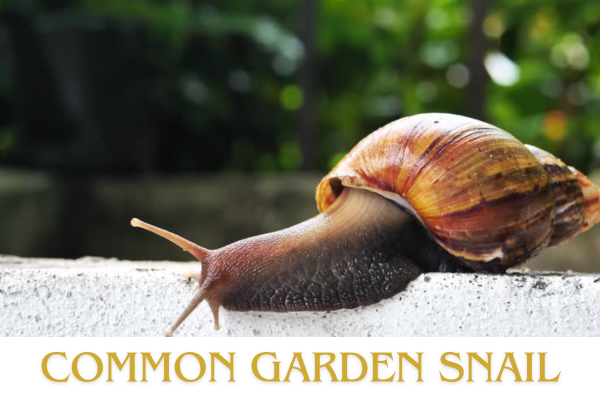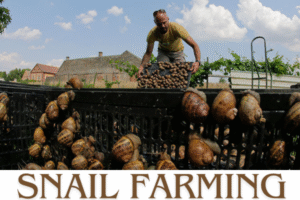🐌Introduction
Indoor Snail Farming in the ever-evolving landscape of agriculture, a quiet revolution is taking place – one that is moving at a snail’s pace. Shell farming, or heliciculture, is emerging as a valuable and rewarding venture for modern farmers.
Beyond their simple appearance, snails are a treasure trove of benefits: their meat is rich in protein and essential nutrients, while being low in fat and cholesterol, making it a healthy addition to many recipes.
Table of Contents
Selecting the Right Snail Species for Indoor Snail Farming
Selecting the appropriate snail species is crucial to the success of your Indoor snail farming venture. Different species have different growth rates, environmental requirements and market demands. Here are some commonly farmed species:
Achatina achatina (Giant Tiger Land Snail)
Known for its large size and rapid growth, this species thrives in warm, humid environments, making it suitable for tropical regions.

Archachatina marginata (Giant West African Snail)
This species matures more slowly, but is highly resilient to changing environmental conditions. It produces high-quality meat and exhibits strong disease resistance, making it ideal for both small- and large-scale farming.

Cornu aspersum (Common Garden Snail)
Also known as French Petit Gris, this variety is adaptable to a variety of climates and is commonly cultivated in Europe.

Site Selection
The location of your Indoor snail farm has a significant impact on the health and productivity of your snails. Consider the following factors:
Soil Quality
Indoor Snail farming requires specific soil conditions to ensure the health and productivity of the snails.The soil not only serves as a habitat, but is also a source of essential nutrients, particularly calcium, which is vital for shell development.
Optimum Soil Conditions for Indoor Snail Farming:
- Soil type: Snails thrive in loose, well-drained soil that retains moisture without becoming waterlogged. Loamy soils rich in organic matter are ideal, as they support good growth and development of snails.
- Soil pH: A slightly acidic to neutral pH range of 6.5 to 7.5 is optimal for snail rearing. Acidic soils (pH less than 6.0) may impede shell development and may need to be neutralized with lime.
- Moisture content: Snails need a moist environment, but not too wet. Soil moisture content should be about 80% of field capacity. Waterlogged soil should be drained to prevent the snails from drowning.
- Calcium availability: Calcium is essential for building a strong shell. The soil must be rich in calcium and, if needed, enriched with calcium sources such as lime or gypsum.
- Avoiding contaminants: Make sure the soil is free of contaminants and microbes. Sterilizing the soil by heating it can eliminate potential threats to the snail’s health.
- Vegetation indicators: If the soil supports the growth of plants like cocoyam, tomatoes and leafy vegetables, it is usually suitable for Indoor snail farming.
By maintaining these soil conditions, you can create a favorable environment for Indoor snail farming, promoting healthy growth and reproduction.
Humidity and Temperature
Maintaining optimum humidity and temperature is important for successful snail rearing.
🌡️ Temperature:
indoor Snails thrive in mild temperatures, ideally between 20°C and 25°C (68°F–77°F). Temperatures below 10°C (50°F) can cause hibernation, halting growth, while temperatures above 30°C (86°F) can cause a state of inactivity due to heat and drought.Consistent temperatures within the optimal range promote active feeding and reproduction.
💧 Humidity:
A high humidity level of 75% to 95% is necessary for snail activity and health. Humidity below 70% can cause dehydration, while excessive humidity above 95% can cause fungal growth and shell problems.Regular misting and proper ventilation help maintain proper humidity levels.
By carefully managing humidity and temperature, you create a favorable environment for the snails to grow and breed effectively.
Shade and Protection:
Indoor Snail farming requires providing proper shade and protection to maintain optimum humidity and temperature, thereby ensuring the health and productivity of the snails.
Natural shade and windbreak:
- Shelter plants: Planting trees such as banana, plantain, papaya, coconut and oil palm around snail enclosures provides natural shade, reducing exposure to direct sunlight and heavy rainfall. These plants also act as windbreaks, reducing moisture loss due to wind.
- Site selection: Selecting a location with natural tree cover or planting fruit trees around enclosures can help reduce wind speed and improve the micro-climate, protecting the snails from harsh environmental conditions.
Artificial Shade Structures:
- Shade nets: In areas that lack natural shade, installing shade nets or constructing shelters using materials such as wood, plastic or metal can provide the necessary protection from direct sunlight and rainfall.
- Housing design: The snail housing should have a well-ventilated system and be well designed for the snails to live in. The help of the anti-miscegenation can be included in controlling the grade and level of the company before inclusion.
Additional Considerations:
- Soil moisture: Maintaining moist, well-drained soil is important, as snails obtain water from the soil and use it to lay eggs. Avoid waterlogged or excessively dry soil to prevent snail mortality.
- Monitoring: Regularly check humidity and temperature levels within snail enclosures to ensure they remain within optimal ranges (humidity: 75%-95%; temperature: 20°C- 25°C).
By implementing these shade and protection strategies, you can create a favorable environment for snail rearing, promoting healthy growth and reproduction
Accessibility
Accessibility plays a vital role in the success of a snail farming enterprise. A well-located farm ensures smooth operations, reduces costs, and improves overall efficiency.Setting Up Your Indoor Snail Farm.
Ideally, the snail farm should be located close to reliable transport routes and markets.
This makes it easier to transport feed, materials and harvested snails, reducing the likelihood of delays and spoilage.
Housing:
Proper housing is essential in snail farming to protect the snails from predators, bad weather and escape.
A good snail house should be cool, moist and well ventilated.Housing types vary from simple wooden boxes and trenches to more advanced greenhouse pens, depending on the size of the farm.
The floor should be filled with fertile, loose soil for burrowing and egg-laying, and the enclosure should be covered with mesh or netting to prevent escape.Shade, humidity control, and cleanliness are important to keep snails healthy and productive.
Well-designed housing creates a safe and comfortable environment, ensuring faster growth and higher yields.
Soil Preparation:
Soil is a vital element in snail farming, as snails use it to move around, feed, and lay eggs.
The ideal soil should be loamy, well-drained, and rich in calcium to support shell growth.Before use, the soil should be cleaned of harmful insects and debris, then loosened for easy burrowing.
Maintain moderate moisture without waterlogging, as excess water can harm the snails.Proper soil preparation ensures a healthy, natural environment that promotes growth, reproduction and overall snail health.
Feeding:
Food is a must for healthy and fast-growing snails. Snails mainly eat soft, leafy vegetables, fruits, and calcium-rich foods such as ground eggshells or limestone, which help build a strong shell.
Food should be fresh, clean and given in the evening when snails are most active. Avoid salty or spicy foods, as they are harmful to snails.
Also, remove leftover food daily to prevent rotting and disease.A balanced and consistent feeding routine promotes growth, enhances reproduction, and ensures a profitable Indoor snail farm.
Watering:
Watering is important in snail farming to maintain humidity so that the snails have a moist environment to survive, move and reproduce.
Snails absorb moisture through their skin and soil, so regular watering keeps them active and healthy.
Use a fine spray to lightly mist the soil and enclosure, especially during dry weather.
Avoid overwatering, as excess moisture can lead to fungal growth or drowning.
Consistent and careful watering ensures a moist habitat, promoting healthy growth and high productivity in Indoor snail farming.
Monitoring:
Regular monitoring is the key to a successful snail farm.
This includes checking the temperature, humidity, soil conditions, and snail behavior to ensure a healthy environment.
Daily inspection helps to detect problems such as pest attacks, shell damage or poor feeding habits early.
Monitoring also includes tracking growth rates and reproduction to manage the farm effectively.
Frequent monitoring helps to maintain optimal conditions, improve snail health and increase farm productivity.
Breeding and Reproduction
Snails are hermaphrodites, which means each snail can lay eggs after mating.
For successful breeding, place mature, healthy snails in soft, calcium-rich soil in a moist, calm environment to lay eggs.
Mating usually occurs under warm, humid conditions, and each snail can lay up to 100 eggs per cycle.
The eggs hatch in 2-4 weeks, depending on temperature and humidity.
Proper care during breeding increases the hatch rate and ensures a constant supply of young snails for your farm.
Health Management:
Effective health management ensures strong, productive snails.
Keep the environment clean, moist and pest-free to prevent diseases and stress.
Remove leftover food regularly, monitor for shell damage, and control ants, rodents, and parasites.
Feed a balanced diet rich in calcium to maintain shell strength and overall health.
Healthy snails grow faster, reproduce more, and cause less loss – making health care a vital part of successful snail farming.
Harvesting and Processing
Harvesting in snail farming begins when the snails reach marketable size – usually 6 to 12 months, depending on the species and care.Mature snails have hard, thick shells with well-formed lips.
Harvesting should be done gently by hand to avoid damaging the shell.
After collection, the snails are cleaned thoroughly to remove dirt and mud.
They are then purified by feeding them clean food or fasting for a few days to clear their digestive system.
Processed snails may be sold live, frozen, or preserved, depending on market demand.
Proper harvesting and clean processing maintains quality, increases shelf life, and ensures customer satisfaction – making this step crucial to profitability.
Marketing and Sales
Effective marketing and sales strategies are crucial to turning Indoor snail farming into a profitable business.
Identify your target customers – restaurants, local markets, exporters or health food stores – and tailor your approach accordingly.
Highlight the benefits of snail products, such as being a lean protein source and an environmentally friendly dish.
Use social media, local fairs and word of mouth to increase awareness and demand.
Offering quality, properly processed snails and reliable supplies helps build trust and repeat business.
Strategic marketing with good customer relations promotes growth and success in Indoor snail farming.
Continuous Learning and Expansion
Success in snail farming depends on continuous learning and smart expansion.
As farming techniques evolve, staying updated with new methods, disease control and feeding methods increases efficiency and productivity.
Attend workshops, join agricultural forums, and network with other farmers to gain information and solve challenges.
Start small, then slowly expand by reinvesting profits, improving housing, or exploring new markets.
Continuous learning empowers farmers to adapt, grow and sustain snail farming business in a competitive market.
Govt Support and Subsidy Scheme
Indoor Snail farming is becoming popular in India as a sustainable and profitable venture, but it currently lacks direct government subsidy schemes.
However, interested snail farmers can take advantage of several existing programmes that support allied sectors and rural entrepreneurship.
- 🐌 Indirect Support Through Allied Schemes national Livestock Mission (NLM): Though primarily focused on livestock such as poultry, sheep and goats, NLM promotes entrepreneurship development in animal husbandry.Under this mission, farmers can explore opportunities for setting up fodder units or integrated farming systems, which can complement snail rearing.
- NABARD Subsidy: National Bank for Agriculture and Rural Development (NABARD) provides subsidy for various agricultural projects.Though it is not limited to snails only, farmers can avail assistance for infrastructure development, training and allied activities that promote snail farming operations.
- 🌱 State-Level Initiatives Mukhyamantri Yuva Swarojgar Yojana (MMYSY): This scheme in Madhya Pradesh provides bank guarantee and loan subsidy to promote entrepreneurship among youth. Snail farmers can apply under this program to get financial assistance for their venture.
- Fal Podharopan Yojana:This scheme supports fruit cultivation by providing subsidy of 40% to 50% of the unit cost. Snail farmers can incorporate fruit plants in their farming system, benefit from this subsidy and also enhance the habitat of snails.
💡 Steps to Access Support
- Research applicable schemes: Identify schemes that align with your snail farming objectives, and focus on those that support infrastructure, training or integrated farming.
- Prepare a Detailed Project Report (DPR): Outline your farm plan, including objectives, methodology, expected results, and financial projections.
- Contact local authorities: Consult agriculture officials or local NABARD representatives to understand the application process and eligibility criteria.
- Apply for assistance: Submit your application along with the DPR to the relevant authorities, ensuring compliance with all requirements.
By availing these schemes, snail farmers can avail financial and infrastructural support, which will help in the growth and sustainability of their enterprises.
Conclusion:
Indoor Snail farming is an emerging, eco-friendly venture with great potential for income and sustainability.
With proper care, the right environment, and continuous learning, farmers can turn small beginnings into a thriving business.
By taking advantage of available resources, including government support and smart marketing, snail farming offers a profitable path toward success in agriculture.
some more Profitable Agri-business is as follows:


7 thoughts on “🐌Indoor Snail Farming”